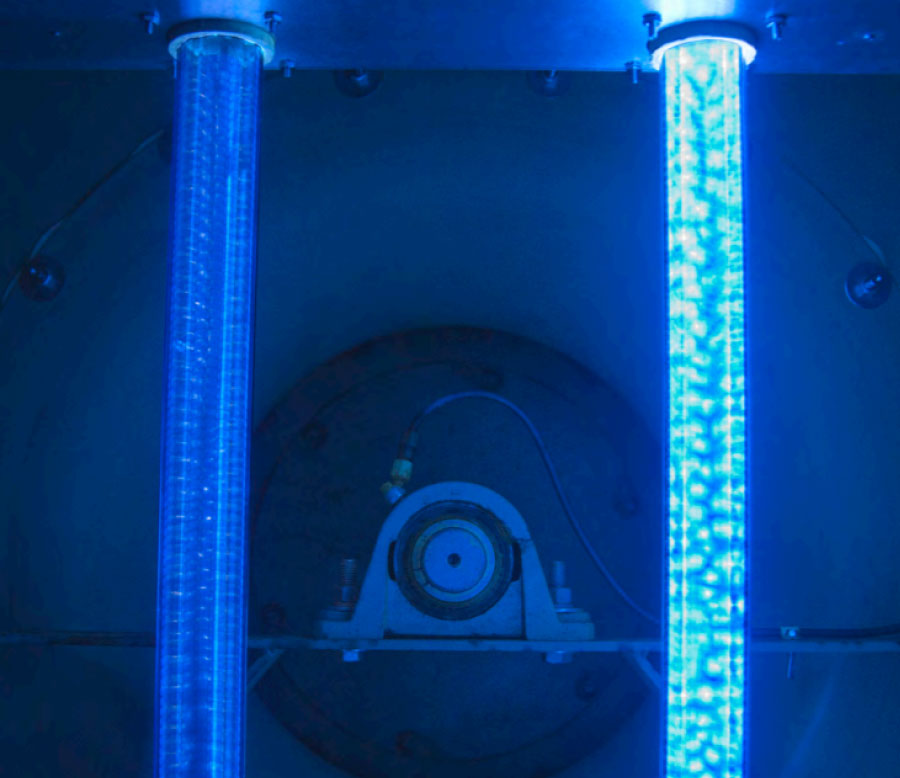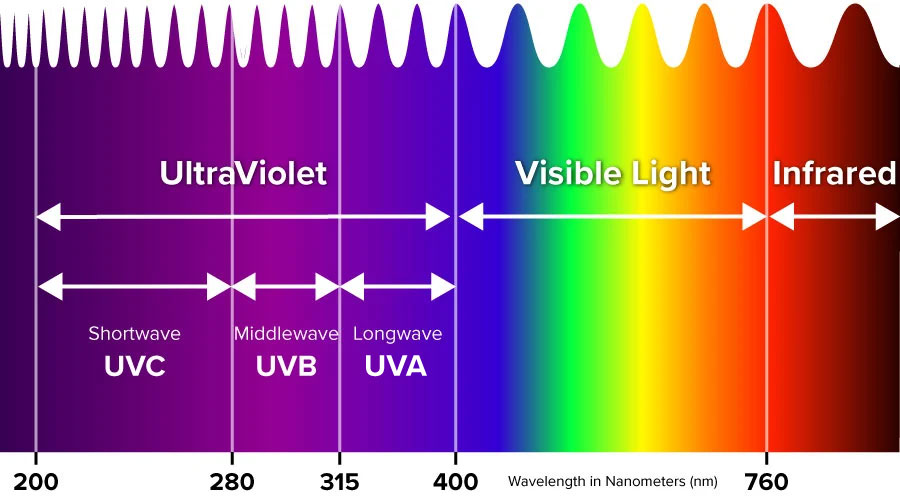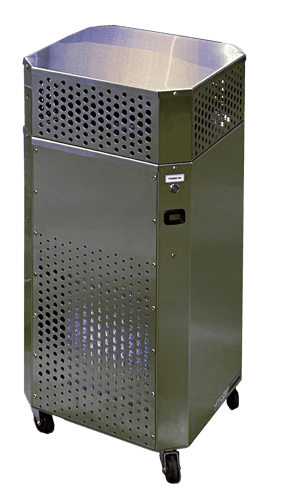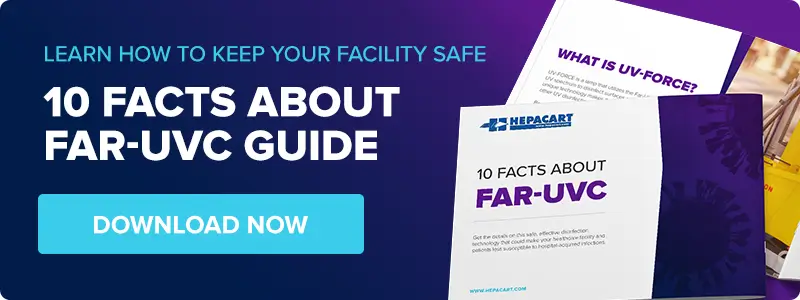Share this
3 Ways Your Facility Could Benefit from Our UV-FORCE® Air Disinfection Module
by Mark Farnsworth on Nov 11, 2020
Far-UVC light can destroy harmful airborne viruses and bacteria in a room safely and effectively.
If you are a hospital facility manager, infection control director, or an operations team leader, you probably know that UV light is an effective solution for disinfection and infection control.
However, a lot has changed in the past several years, so in this article, we'll take a new look at disinfecting the air in your facility, including using a specific piece of equipment that is relatively new — one that uses an incredibly effective wavelength of ultraviolet light.
Keeping indoor air clean is more critical than ever.
As the events of 2020 have triggered a demand for effective ways to make indoor spaces safe from the SARS-CoV-2 coronavirus, interest in germicidal UV has grown. Some installations mount conventional UVC in a high ceiling behind shielding to prevent human exposure and use fans to circulate the air within a room. The air circulation both diffuses airborne viruses and moves them past the UV lights. Shielding is necessary for these types of installations because conventional UVC can penetrate the skin and eyes, causing problems.
To avoid this health hazard, some use this disinfection method at night only. For instance, New York City's Metropolitan Transport Authority shuts down nightly for four hours to disinfect buses, subway cars, and stations using powerful UVC lamps.
Obviously, overnight cleaning alone does little for daytime occupants of crowded spaces, so what's needed is something safer than UVC — something that can be used during the day when disinfection is critical in real-time.

Several years ago, it was discovered that the very short wavelengths at the far end of the UVC spectrum, at 222 nanometers, were not only unable to penetrate eyes and skin but were far more effective at destroying airborne pathogens. (More detail about that below.)
The twin claims of safety around humans and a much higher pathogen inactivate rate may sound extraordinary if you haven't been following advances in germicidal UV. But repeated testing, including a recent test of effectiveness against coronaviruses, has verified those results.
The equipment we're recommending is our UV-FORCE® Air Disinfection Module (UV-FORCE module), which uses 222-nm far-UVC light to inactivate 99.99% of the virus-sized pathogens (smaller than 0.3 nm) that pass through it, as well as 99.999% of those larger than 0.3 nm.
The UV-FORCE module attaches to nearly any HEPA-filtered negative air machine on the market via 12-inch ducting, as well as our AnteRooms and HEPACART® Mobile Containment Carts.
Let's start by reviewing how far-UV works, and then we'll examine various ways in which the UV-FORCE module could be connected within your occupied facility to disinfect the air.
Here’s a quick refresher on UVA, UVB, and UVC light.
With a wavelength between 100 and 400 nanometers (billionths of a meter), ultraviolet light is invisible to the eye. It sits just below the visible spectrum, which ranges from a high of 740 nm (the upper end of red) down to 380 nm (the lower end of violet). So "ultraviolet" was coined to mean "really short wavelengths like violet, only more so."
Within the category of ultraviolet, there are subtypes also divided by the difference in wavelengths. Most commonly, you will see UV light divided into A, B, and C subtypes with A having the longest wavelength (320nm to 400nm) and C having the shortest (100nm to 290nm). UVA light is also referred to as “blacklight,” UVB light (290nm to 320nm) is what causes sunburns in humans... and UVC light is mostly absorbed by [ozone in the] the atmosphere, so we have little contact with this type of light.

Another way to divide the UV spectrum is by near-UV (400 down to 300 nm), middle-UV (300-200), far-UV (200-10), and extreme-UV (<10). Since the relatively recent discovery of a very narrow range of particularly effective and safe germicidal wavelengths around 222nm, far-UVC has been the term commonly used to refer to that wavelength.
Why is far-UVC better than UVC?
The destructive effect of UVC on microorganisms has been proven in years of use, eliminating pathogens such as viruses including influenza, measles, SARS-CoV-2, bacteria, fungi, and mold spores. While this does render the pathogens unable to infect, UVC has some well-documented drawbacks: it's dangerous to the eyes and skin, and it causes rapid aging of rubber and plastic if used repeatedly in the same environment.

Far-UVC, on the other hand, ranging between 207 to 222 nanometers, is also powerful and effective at destroying pathogens but without harming human tissue, thus making it the best and safest UV option for effective disinfection. 222-nm far-UVC LED lamps are at the core of HEPACART's UV-FORCE technology.
Here are three ways to use Far-UVC in your facility.
1. Use UV-FORCE as an air disinfectant during construction.
Hospital construction and expansion creates lots of dust and debris in occupied facilities. That's why we have the Infection Control Risk Assessment Matrix, which lists precautions for construction and renovation. However, it’s not really the dust that’s the problem. When particularly dusty (Type D) construction occurs around high-risk patients, pathogens such as viruses, bacteria, and mold spores tend to hitch a ride on those dust particles. HEPACART® has HEPA-filtered products that do a great job of removing contaminated dust and particles as small as 0.3 micrometers from the air in situations where external venting is not practical or is deemed risky.
To deal with exceptionally contagious pathogens smaller than 0.3 µm, like the virus that causes COVID-19, you can attach an airborne pathogen disinfection module such as the UV-FORCE with the negative air machine that's controlling room air pressure through an anteroom covering the door to the room.
2. Use UV-FORCE with a negative air machine to contain infectious diseases.
Similarly, UV-FORCE modules should be used where patient isolation is necessary due to infectious disease outbreaks — measles, coronavirus, tuberculosis, and influenza. Our AnteRoom paired with our HEPA-filtered HEPAFORCE® Negative Air Machine and our UV-FORCE captures or inactivate 99.99% of these tiny cells, allowing you to safely isolate the patient while keeping pathogens from leaving the room.

3. Use UV-FORCE with a ceiling access cart during above-ceiling maintenance.
Another scenario is above-ceiling maintenance, where the UV-FORCE module has been used with our HEPACART® Mobile Containment Cart as a safe and convenient substitute for external venting. Additionally, pairing a UV-FORCE module with a HEPA-filtered negative air machine throws a double whammy on contaminated air, ensuring that you're doing the maximum possible to keep staff and occupants safe.
Conclusion
To learn more about how our UV-FORCE Air Disinfection Module uses far-UVC light as an air disinfectant, download the UV-FORCE product brochure. UV-FORCE is a tool you'll want to have in your infection control arsenal.
Resources
- What is UV-FORCE Technology?
- Q & A About Far-UV with Dr. David Brenner, Director of Columbia
- University's Center for Radiological Research (TED video - 30 min.)
- Far-UVC Light Safely Inactivates Airborne Coronaviruses (Columbia University, June 2020)
- Here’s How NYC Is Using Powerful Uv Light To Inactivate the Coronavirus on Subways and Buses


